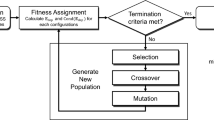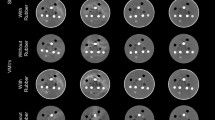Abstract
BeO ceramics (Thermalox® 995, Materion Corp.) can function as thermoluminescent dosimeters (TLDs) with a tissue-equivalent effective atomic number and sufficient high solidity which can be used as postal dosimeters. To evaluate the feasibility of employing BeO ceramic in proton dosimetry, we investigated the dose–response and the linear energy transfer (LET) dependence of a BeO ceramic TLD. As the BeO ceramic TLDs exhibit two glow peaks, the dose–responses of the integral thermoluminescence (TL) signals for the low-temperature (GL) and high-temperature (GH) glow peaks, as well as those for entire TL signal (GT), were all investigated in this study. The irradiation doses were 0.5, 1.0, 2.0, and 5.0 Gy, and the LET dependence of the TL efficiency was investigated between 0.53 and 7.42 keVµm−1. All experiments were performed using a 160 MeV proton beam at NIRS-HIMAC in Japan. The TL intensities of GL, GH, and GT increased with increasing irradiation dose. The relation between the TL intensity and irradiation dose could be expressed as a function of a quadratic polynomial equation. The TL efficiencies of glow peaks (GH and GT) decreased with decreasing LET, while no significant correlation was observed between GL and LET. The shape of the glow curve of the BeO ceramic depends on the irradiation dose and LET.







Similar content being viewed by others
Data availability
All data generated or analyzed during this study are included in this published article.
References
J. Izewska, P. Bera, S. Vatnitsky, M. Radiation, P. Section, I. Atomic, E. Agency, Radiat. Prot. Dosim. 101, 387 (2002)
J. Izewska, T. Bokulic, P. Kazantsev, P. Wesolowska, D. van der Merwe, Acta Oncol. 59, 495 (2020)
W.G. Tochilin, E. Goldstein, N. Miller, Health Phys. 16, 1 (1969)
P.J. Fox, R.A. Akber, J.R. Prescott, J. Phys. D Appl. Phys. 21, 189 (1988)
A.M. Noh, Y.M. Amin, R.H. Mahat, D.A. Bradley, Radiat. Phys. Chem. 61, 497 (2001)
J.F. Agirre, R. Tailor, G. IBBOTT, M. STOVALL, and W. HANSON, IAEA-CN-96-82 191 (2002)
M. Jermann, Int. J. Part. 2(1), 50–54 (2015)
W. Hoffmann, J. Bienen, D. Filges, T. Schmitz, Radiat. Prot. Dosim. 85, 341 (1999)
H. Yasuda, Publ. Nucl. Technol. 87, 115 (2000)
H. Yasuda, K. Fujitaka, Radiat. Prot. Dosim. 87, 203 (2000)
H. Yasuda, K. Fujitaka, Radiat. Meas. 32, 355 (2000)
M. Sadel, P. Bilski, J. Swakoń, A. Weber, Radiat. Prot. Dosim. 168, 27 (2014)
K. Shinsho, Y. Koba, G. Wakabayashi, S. Tamatsu, S. Fukuda, R. Morimoto, D. Maruyama, H. Saitoh, N. Sakurai, Radiat. Meas. 62, 15 (2014)
Y. Koba, K. Shinsho, S. Tamatsu, S. Fukuda, G. Wakabayashi, Radiat. Prot. Dosim. 1(1–4), 437–440 (2014)
W. Chang, Y. Koba, S. Fukuda, G. Wakabayashi, H. Saitoh, K. Shinsho, J. Nucl. Sci. Technol. 53(12), 2028–2033 (2016)
D. Maruyama, S. Yanagisawa, Y. Koba, T. Andou, K. Shinsho, Sens. Mater. 32, 1461 (2020)
S. Yanagisawa, D. Maruyama, R. Oh, Y. Koba, T. Andoh, K. Shinsho, Sens. Mater. 32, 1479 (2020)
Y. Koba, W. Chang, K. Shinsho, S. Yanagisawa, G. Wakabayashi, K. Matsumoto, H. Ushiba, T. Ando, Sens. Mater. 28, 881 (2016)
M. Sommer, R. Freudenberg, J. Henniger, Radiat. Meas. 42, 617 (2007)
M. Tanaka, R. Oh, N. Sugioka, H. Tanaka, T. Takata, G. Wakabayashi, S. Sugawara, K. Watanabe, A. Uritani, S. Yoshihashi, K. Nagasaka, G. Okada, T. Negishi, K. Shinsho, J. Mater. Sci. Mater. Electron. 33, 20271 (2022)
N. Matsubayashi, N. Hu, T. Takata, A. Sasaki, T. Mukawa, K. Suga, Y. Sakurai, H. Tanaka, SSRN Electron. J. 161, 106900 (2022)
K. Shinsho, in Phosphors Radiat. Detect, ed by T. Yanagida, M. Koshimizu (Wiley, New Jersey, 2022), p. 416
N. Koshio, H. Takagi, D. Maruyama, S. Yanagisawa, G. Okada, K. Shinsho, in 80th JSAP Autumn Meeding (2019)
ICRU, ICRU Report 16Linear Energy Transfer, (1970)
T. Berger, M. Hajek, M. Fugger, N. Vana, Radiat. Prot. Dosim. 120, 361 (2006)
P. Bilski, Radiat. Meas. 45, 42 (2010)
Acknowledgements
The authors would like to express their thanks to the staff at Accelerator Engineering Corporation. This work was conducted as a part of the Research Project with Heavy Ions at QST-HIMAC.
Funding
We did not accept any funding for this study.
Author information
Authors and Affiliations
Contributions
All authors contributed to the study conception and design. Material preparation, data collection, and analysis were performed by WC, SS, YK, KO, GO, and KS. The first draft of the manuscript was written by WC and all authors commented on previous versions of the manuscript.
Corresponding author
Ethics declarations
Conflicts of interest.
All the authors have no conflicts of interest to declare.
Informed consent
Since the authors have nothing to declare and no human participants/animals are involved in this study, no informed consent is needed.
Research involving Human/or Animals and Participants
No human participants/animals are involved in this study.
Additional information
Publisher’s Note
Springer Nature remains neutral with regard to jurisdictional claims in published maps and institutional affiliations.
Rights and permissions
Springer Nature or its licensor (e.g. a society or other partner) holds exclusive rights to this article under a publishing agreement with the author(s) or other rightsholder(s); author self-archiving of the accepted manuscript version of this article is solely governed by the terms of such publishing agreement and applicable law.
About this article
Cite this article
Chang, W., Sugawara, S., Koba, Y. et al. Thermoluminescence response of a BeO ceramic dosimeter in therapeutic proton beam. J Mater Sci: Mater Electron 34, 1606 (2023). https://doi.org/10.1007/s10854-023-10984-9
Received:
Accepted:
Published:
DOI: https://doi.org/10.1007/s10854-023-10984-9




